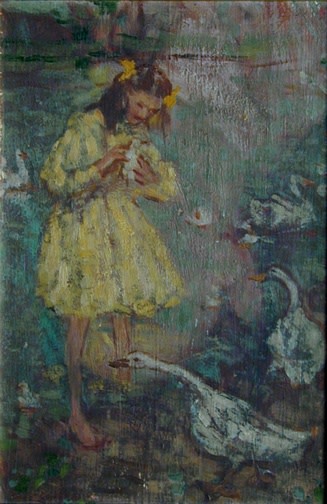A Play of Color in Emily Coonan’s Whimsical "Duck Pond" (c. 1910)
The Duck Pond encapsulates Emily Coonan’s remarkable skill at conveying the essence of her chosen subject through a distilled and distinctive visual vocabulary. Stemming from the epoch of her professional debut, and possibly exhibited in the 1910 Spring Exhibition at the Art Association of Montreal, it is a small, spontaneously executed painting that is emblematic of the artist’s earliest stylistic and thematic concerns, conforming to her interest in portraying prosaic, peopled vignettes of the world she knew or imagined.

Emily Coonan, The Duck Pond, c. 1910, oil on panel, 11 1/2 x 7 3/4 in.
Possibly exhibited in the 1910 Spring Exhibition at the Art Association of Montreal.
Here, a girl in a gauzy yellow frock is observed standing by a pond’s edge holding a small duckling. Several white-feathered ducks surround her, completing the composition and reinforcing the whimsical spirit of the scene. Despite its initial, historically inscribed pictorial appeal, it is the visual vigour and virtuosity of the image that compels one’s lingering interest. Dazzling passages of colour—marigold yellow and emerald green—are interspaced across a dusky backdrop, illustrating Coonan’s consummate facility and finesse as a colourist.
Similarly, the compressed, shallow space of the composition, its broken brushwork and near-decorous articulation of imagistic motifs speak of the artist’s familiarity and engagement with an emergent modernist syntax. As in her overall practice, from her early work forward, it is Coonan’s emphasis on exploring the formal dynamics of the activity of painting—the simple, schematized rendering of elements, the cadenced patterning and play of chromatics—which affords her oeuvre its resonant force.
Like many women artists of her generation, Coonan’s imagistic repertoire at first drew from the well-spring of her immediate experience—a world of women and Edwardian domesticity. In her early career, she frequently portrayed children engaged in quotidian activity, at times in interior settings, at other times out-of-doors. Yet still, the built or natural environments she depicted were from the outset minimally-rendered, anonymous grounds against which to set her subjects. In that regard they anticipated her later Quebec landscapes which were unmarked and unpopulated, eschewing both cultural referents and the pre-Cambrian idiom of the Group of Seven in favour of an emphasis on painterly effects. And while her subject matter did derive, for a time at least, from the nucleus of hearth and home, her swift, simultaneous assimilation of progressive visual vocabularies served to circumvent her works’ entry into the "spaces of sentiment" not uncommonly still associated with a contemporaneous "feminine aesthetic."
Acclaimed by art commentators of the day as an "artist who was born and not made" who belonged to "no school and imitates nobody," Coonan’s early success lay ultimately in the distinctiveness of her painting decisions and output within the context of a rapidly changing, albeit uneasily evolving, art-making milieu. Coonan was among a number of innovatory Montreal artists of the early twentieth century, including Henrietta Mabel May, A.Y. Jackson and Prudence Heward, who pursued their formal art studies at the School of the Art Association of Montreal guided by the influential artist and educator William Brymner.
As a pupil there beginning in 1905, she was the recipient of several prizes and scholarships and, in 1914, she was the first artist to be awarded the newly established Traveling Scholarship by the Trustees of the National Gallery. While her trip would be deferred until 1920 due to the advent of WW1, her first European study sojourn in 1912, accompanied by H. Mabel May, not only served to hone her aesthetic acumen and widen her iconographic repertoire to encompass cityscapes and landscapes but, more importantly, effectively secured her reputation as a serious professional practitioner.
In common with ascendant women artists of the era, Coonan’s engagement in the public sphere was committed and consistent. During the teens and twenties she was a regular participant in the Art Association’s Spring Exhibitions, in Royal Canadian Academy shows and with the Canadian National Exhibitions held in Toronto. She was also one of the first women artists, along with Lilias Torrance Newton, invited to exhibit with the Group of Seven, and in 1924, her canvas Girl in Dotted Dress (Art Gallery of Hamilton) was selected for inclusion in the British Empire Exhibition at Wembley, England.
Coonan was also initially associated with Montreal’s Beaver Hall Group, but her independent spirit precluded an ongoing affiliation with this loose collective of artists. Throughout the 1920’s and ‘30’s the artist’s oeuvre continued to demonstrate her ongoing interest in early modernist aesthetic ideas and the pursuit of "significant form" as expressed both in her eloquent enigmatic figurative paintings and in the evocative landscapes which she would explore the length of her life.
Regrettably, unknown circumstances precipitated Coonan’s premature retreat from active participation in Montreal’s artistic scene in the mid-thirties. Given her stature among the country’s most innovative women artists of the early twentieth century, this event can only be regarded as a significant loss within the context of the history of Canadian art.
© Copyright Karen Antaki & Galerie Walter Klinkhoff Inc.
For a full discussion of Emily Coonan’s work, see Karen Antaki and Sandra Paikowsky, Emily Coonan, 1885 -1971 (Montreal: Concordia Art Gallery, 1987).








